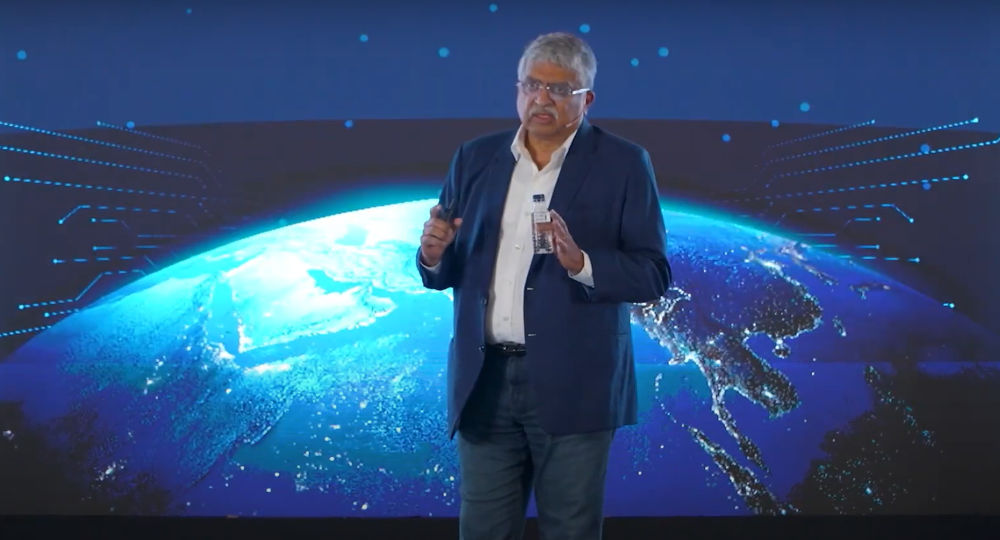[Screengrab from Nandan Nilekani's presentation, The Great Unlock: India in 2035, at VC firm Arkam Ventures Annual Meet in Bengaluru]
Nandan Nilekani’s recent speech on The Great Unlock: India in 2035 at VC firm Arkam Ventures Annual Meet in Bengaluru has evoked plenty of chatter. Part of that excitement comes from the broader context. The mood in India is not as exuberant as it used to be. Growth seems to have plateaued. No one talks about “animal spirits”. The rupee is weakening. There are concerns about Trump’s tariffs. The launch of DeepSeek earlier this year deflated some of the swagger even among the tech community, which prided itself on frugal innovation. Wherever one turned, two questions seemed to be hanging on the top of everyone’s head. Where are we? Where are we going?
Amidst this gloom and uncertainty, Nilekani’s speech injected a sense of coherence. His speech captured what changed in the Indian market opportunity, how technology can galvanise growth—and what we need to do to take entrepreneurship to the next level. And therefore, it is important to pause and consider what he has laid out.
There is another reason why we need to pay heed. It comes ten years after his famous WhatsApp Moment speech. And that’s a good place to start. In 2015, he gave a speech elaborating on what he called a "WhatsApp moment” for the Indian banking sector.
In that speech, he argued that WhatsApp's phenomenal success was driven by many factors.
-
The network effect created a virtuous cycle: as more people joined, the platform's value increased, attracting even more users. This effect was amplified by strategic decisions: using phone numbers as identity simplified account creation; leveraging the phone's contact list as a social graph enhanced virality, and offering free messages provided an advantage over traditional communication platforms.
-
The platform was simultaneously riding existing technological trends — the shift from voice to data communication and the transition from feature phones to smartphones. Nilekani noted that WhatsApp was often referred to as "free SMS" in rural India.
-
Additional macro trends sustained this virtuous cycle's momentum. Smartphone prices were declining, which accelerated adoption rates. Broadband internet was becoming more affordable.
The result: “WhatsApp does 30 billion messages a day. All the telecom operators on the planet put together do only 20 billion SMS a day. In other words, one company started by a Ukrainian migrant with 40 Engineers has 50% more messaging volume than all the telcos put together,” Nilekani said. That was the WhatsApp moment for telecom players.
UPI: From Prediction to Reality
Nilekani went on to use this analogy to predict that UPI was going to have a similar impact on the banking sector. Indian banking would face its own WhatsApp moment — driven by similar factors.
There was a virtuous cycle at play: as more users and merchants adopted the platform, its utility would grow for everyone, attracting more users.
There were existing trends supporting this transformation: Electronic clearing of cheques had surpassed manual paper clearing by 2014. IMPS was gaining traction. People were becoming familiar with mobile wallets from companies such as Paytm. E-commerce was projected to grow four times in five years, with digital payments in e-commerce expected to increase from 40% to 80%.
And there were additional mega trends: widespread smartphone adoption (projected to reach 600 million by 2020), Aadhaar-based authentication (enabling single-click two-factor verification), and regulatory innovations like payment banks.
I attended the speech live. And I could sense both excitement and scepticism among the audience. This was Bengaluru, and the room was mostly filled with technology optimists. They were excited. But there were also sceptics. Tech predictions are a dime a dozen. Every consultant makes predictions. Some come true. Many don’t. Their scepticism was justified — at that time.
Now, in 2025. UPI has indeed become huge (in January this year, there were nearly 17 billion transactions on UPI). It has spawned several products and companies (one of them, PhonePe, is valued at $12 billion) and is seen as one of the most important innovations to come out of India. UPI also helped push Digital Public Infrastructure (DPI) as a key element of public policy, and in fact, a driver of India’s soft power. In 2023, G20 ministers recognized DPI as an accelerator of global goals.
Nandan’s Arkam talk was well timed - it came 10 years after his ‘WhatsApp Moment’ speech, and looked ten years into the future.
Confronting India's Economic Challenges
In his presentation, Nilekani spoke about challenges and opportunities ahead for India. The country grapples with stark spatial inequality, with only 13 out of 788 districts contributing to half of its GDP. Income disparity is severe, as the top 10% earn 60% of national income while the bottom 50% average just Rs 71,000 annually. Productivity remains low at $7 per hour, compared to $28 in China and $82 in the US. The informal economy is pervasive, with only 15% of the workforce formalized, and out of 63 million MSMEs, just 8 million file GST. Additionally, 50% of India's wealth is tied up in land, which remains largely unmonetizable due to fragmented ownership and outdated systems.
To address these challenges, Nilekani proposed four key "unlocks": technology, capital, entrepreneurship, and formalization.
-
The technology unlock focuses on harnessing AI to reach a billion Indians, particularly in areas like agriculture, education, and MSMEs.
-
The capital unlock aims to leverage tokenization of illiquid assets and the Account Aggregator framework to improve capital efficiency and financial inclusion.
-
The entrepreneurship unlock envisions creating one million startups and ten million modern MSMEs by 2035, fostering a vibrant ecosystem that generates employment and fuels innovation.
-
The formalization unlock seeks to implement portable credentials and benefits systems for workers while simplifying regulations to improve ease of business.
If India plays this right, it could have a transformative impact on its economy. It could potentially reach a $8 trillion GDP by 2035, up from the projected $6 trillion under current growth rates. The country could have one million startups by 2035.
These developments will drive job creation, innovation, and address regional disparities, with half of all startups projected to emerge outside major metros. The formalization of the economy would bring more businesses into the GST net, improve access to capital and markets for MSMEs, and increase workforce participation in the formal sector.
As we pointed out, such optimism might seem contrarian for the times we live in. There are two devastating wars going on right now, and several smaller conflicts across the world. Countries are putting up trade barriers following the lead of the Trump administration. The stock market is down. Businesses are laying off employees. Infosys itself is firing trainees at its Mysore campus.
Yet, we should pay heed to Nilekani, for the reasoning he employed here is as strong as the one that backed his bet on UPI: there is a virtuous cycle at play, we can already see the evidence of this trending, and there are other macroeconomic factors driving this trend.
A Million Tigers: The Logic
Let’s take his prediction of India getting to 1 million startups by 2035, growing from approximately 150,000 startups today. Here are the facts he pointed out in his speech, slightly reorganised.
The Virtuous Cycle
Nilekani described a powerful "binary fission" effect where successful startups spawn new startups:
-
Successful founders become Angels: Entrepreneurs who succeed are reinvesting in the next generation of startups. For example, founders like Kunal Shah are funding hundreds of new ventures.
-
Talent multiplies: Employees from successful startups like Flipkart go on to start their own companies. From Flipkart alone, former employees have created companies like PhonePe, Groww, Spinny, and Slice.
-
IPO creates wealth: Every IPO creates wealth that fuels hundreds more startups as employees cash in their stock options and start new ventures.
Existing Trend
The startup ecosystem is already expanding:
-
In 2016, India had only a few thousand startups, with about 1,000 being funded. Today, it has expanded to approximately 150,000 startups, representing a big increase in 7-8 years.
-
Half of all startups are now outside the eight major metros, addressing spatial inequality and creating opportunities across India.
-
Companies like JAR (digital savings), Anorg (supporting street hawkers), and Meesho (enabling first-time sellers) are reimagining traditional businesses for the digital age.
Macro Drivers
There are other macrotrends fueling this startup explosion:
-
Digital Infrastructure: The foundation laid by Aadhaar, UPI, DigiLocker, and other digital public infrastructure has dramatically reduced costs and barriers to entry. For example, EKYC costs dropped from $23 to $0.50, enabling mass adoption of financial services.
-
Smartphone Penetration: Over 500 million Indians now have smartphones, with this number expected to reach 900 million to 1 billion in the coming years.
-
AI: New AI technologies are breaking down language barriers, making digital services accessible in all Indian languages and dialects, expanding the addressable market.
-
Capital Availability: India now has a complete lifecycle of capital from seed to IPO, with 7,900+ angels, venture capital firms, family offices, and private equity investors supporting startups at every stage.
-
Retail Investment: The rise of retail investors (100 million unique equity investors) and SIP investments ($24 billion annually) is creating a robust IPO market that allows successful startups to go public in India.
Beyond Metrics
Even as I write this, I am aware that it sounds a lot like something a management consultant might have put together. So, what’s really different here?
During our reporting on Aadhaar, Charles Assisi and I have had long discussions about Nandan Nilekani's persistent optimism despite heavy opposition to his projects.
We concluded that two things distinguished Nilekani's worldview from that of typical consulting firms like McKinsey or BCG:
First, he held a strong belief that truly beneficial technology would generate organic demand from people. (When facing opposition to Aadhaar within the Congress Party, he convinced Sonia Gandhi by showing photographs of long queues of people waiting to get registered in small towns and villages.)
His "unlock" strategy is grounded in this belief. Listening to his speech, one could sense his conviction that the startup revolution would not just create wealth but also address deep-rooted social and economic challenges. He believes that it could
-
Address spatial inequality: Only 13 districts out of 788 currently contribute to half of India's GDP. Startups are spreading economic opportunity more evenly across the country.
-
Formalize the economy: Only 15% of Indians are currently in the formal economy (compared to 60% in Brazil). Startups are creating pathways to formalization through digital platforms.
-
Improve Productivity: India's productivity ($7/hour) lags significantly behind China ($28/hour) and the US ($82/hour). Tech-enabled startups are helping to close this gap.
-
Create jobs: New work models through platforms like Urban Company (service providers), Rapido (9 million drivers), and Zetwork (factory aggregation) are generating millions of formal and gig economy jobs.
-
Democratize access: Startups are making services accessible to previously underserved populations, from education (PhysicsWallah) to financial services (Credit B reaching 18,000 pincodes).
The second distinguishing factor is that Nilekani actively rolls up his sleeves to create change. He didn't just discuss the "WhatsApp moment" for banking; he was instrumental in creating UPI. Similarly, through Ek Step Foundation, which he co-founded with Shankar Maruwada, he is working to unlock technological potential.
As he seems to believe: the best way to predict the future is to help create it.



